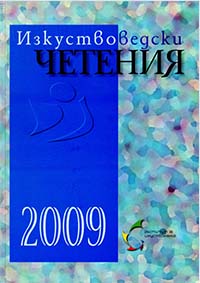За „ниското" и „високото" в модела „Съвременно изкуство" от началото на XX век (художници и визуална политика на в.„Българан" и сп. „Художник")
About 'High' and 'Low' in the Model of 'Contemporary Art' from the beginning of the 20th century (Artists and visual policy of the newspaper Balgaran
Author(s): Milena GeorgievaSubject(s): Theatre, Dance, Performing Arts
Published by: Институт за изследване на изкуствата, Българска академия на науките
Summary/Abstract: On the basis of the contrast between the newspaper Balgaran (1904-1909) and the magazine Hudozhnik (1905-1909) the author makes a comparison and considers that the two publications reflect the 'high' and 'low' in Bulgarian periodic press from the beginning of the 20th century. Following a detailed analysis of the authors of the two publications and the artists a conclusion is reached that the two magazines are the first visual modernistic publications in Bulgarian periodic press. Hudozhnik represents the sphere of high values, Balgaran - low, popular art. These two publications create a new type of culture. They are the product of urban, or to be more particular - the self-consciousness of the capital and Hudozhnik is associated not only with 'high' culture but in general with the European, while Balgaran is an example of the 'low' but not of the 'degraded', the banal and it places a special accent on the connotation with the typical Balkan. The contrast between them is not that of subordination but of relativity. Special attention is dedicated to contributors, such as Alexander Balabanov and Alexander Bozhinov who are mediators of the visual art between the two publications. Their materials are important for the two magazines. The article proves that in both publications the visual policy is held by artists-members of the modern society Savremenno Izkustvo (Modern Art), but they are strictly separated contrary to the writers that published in both publications. This is connected with the wide-aspect aesthetic program of the society for total impact of art on life - an idea that certainly has a European context. A comparison is made with the magazine Misal - a mentor in literary life during that time, and its reflection in the comic eyepiece of the magazine Balgaran. The light playful humor of the Balgaran's connected with their bohemian way of life contained new, non-admissible for serious magazines topics, such as eroticism, women, wine, merriment, and life's little pleasures. To this were added politics or the inventing of new heroes of subculture, such as the shopi of E. Pelin, artistically embodied in the drawings of Al. Bozhinov. The main conclusion is that the creative figures and the visual policy of the two publications present two sides of the cultural project, called Savremenno iskustvo (Contemporary Art). Even though Hudozhnik represents 'high' elevated culture while Balgaran - 'low', humoristic, bohemian culture in relation to European models both publications are the product of urban elite culture.
Journal: Изкуствоведски четения
- Issue Year: 2009
- Issue No: 5
- Page Range: 210-218
- Page Count: 9
- Language: Bulgarian
- Content File-PDF

